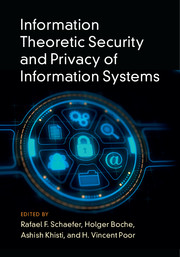Book contents
- Frontmatter
- Contents
- List of Contributors
- Preface
- Part I Theoretical Foundations
- 1 Effective Secrecy: Reliability, Confusion, and Stealth
- 2 Error-Free Perfect Secrecy Systems
- 3 Secure Source Coding
- 4 Networked Secure Source Coding
- Part II Secure Communication
- Part III Secret Key Generation and Authentication
- Part IV Data Systems and Related Applications
- Index
- References
3 - Secure Source Coding
from Part I - Theoretical Foundations
Published online by Cambridge University Press: 28 June 2017
- Frontmatter
- Contents
- List of Contributors
- Preface
- Part I Theoretical Foundations
- 1 Effective Secrecy: Reliability, Confusion, and Stealth
- 2 Error-Free Perfect Secrecy Systems
- 3 Secure Source Coding
- 4 Networked Secure Source Coding
- Part II Secure Communication
- Part III Secret Key Generation and Authentication
- Part IV Data Systems and Related Applications
- Index
- References
Summary
This chapter assumes that a limited amount of secret key and reliable communication are available for use in encoding and transmitting a stochastic signal. The chapter starts at the beginning, with a more general proof of Shannon's “key must be as large as the message” result that holds even for stochastic encoders.
Three directions are explored. First, for lossless compression and perfect secrecy, variable length codes or key regeneration allow for a tradeoff between efficiency of compression and efficiency of secret key usage. Second, the relaxation to imperfect secrecy is studied. This is accomplished by measuring the level of secrecy either by applying a distortion metric to the eavesdropper's best possible reconstruction or by considering the eavesdropper's ability to guess the source realization. Finally, an additional relaxation is made to allow the compression of the source to be lossy.
The chapter concludes by showing how the oft-used equivocation metric for information theoretic secrecy is a particular special case of the rate–distortion theory contained herein.
Introduction
Source coding is the process of encoding information signals for transmission through digital channels. Since efficiency is a primary concern in this process, the phrase “source coding” is often used interchangeably with “data compression.” The relationship between source coding and channel coding is that channel coding produces digital resources from natural resources (e.g., a physical medium), and source coding consumes digital resources to accomplish a task involving information, often simply moving it from one point to another.
The channel coding side of information theoretic security is referred to as physical layer security. This usually involves designing a communication system for a physical wiretap channel, introduced by Wyner in [1], which produces a provably secure digital communication link. Another important challenge in physical layer security is the production of a secret key based on common observations, such as channel fading parameters or prepared quantum states. Although a key agreement protocol does not necessarily involve a channel, it is consistent with the spirit of channel coding in that the objective is the production of digital resources.
- Type
- Chapter
- Information
- Publisher: Cambridge University PressPrint publication year: 2017

